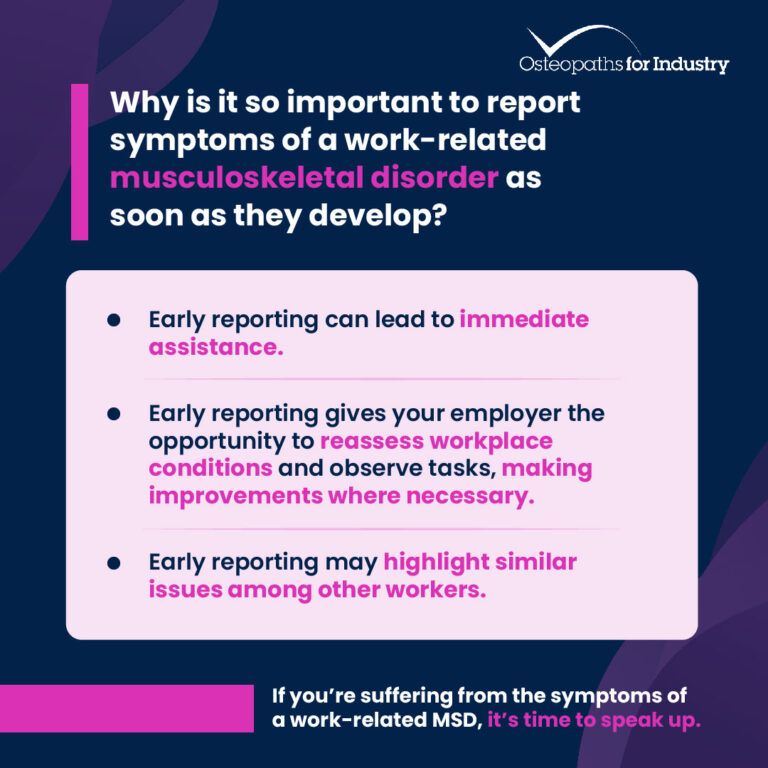Musculoskeletal disorders (MSDs), which affect the back, joints, and limbs, can pose a vast array of challenges in the workplace. However, as an employee, there are steps you can take to address and manage these conditions in collaboration with your employer. Knowing what steps to take if you suspect you have an MSD is integral to your health and happiness both at work and outside of your job, as is understanding your employer’s responsibilities to support you and knowing how you can seek help if you’re struggling with any aspect of your musculoskeletal health.
Recognising and Reporting Symptoms
If you’re experiencing symptoms of an MSD, e.g., back pain, it’s crucial to report this promptly to your manager, supervisor, health and safety representative, or another worker representative. Why?
- Early reporting can lead to immediate assistance, if available. If you fail to report issues promptly, your injuries may worsen or become long-term.
- This will give your employer the opportunity to reassess workplace conditions and observe your tasks in order to make improvements where required. This can limit the risk of re-aggravating an injury or causing a new one for either yourself or your colleagues.
- Similar issues among other workers may be identified, and unless you tell someone, your employer may not recognise there’s a more widespread problem affecting multiple members of staff.

Early intervention is critical to a complete recovery from MSDs, so communication with your employer is key!
Risk Factors
The first step towards managing MSDs and seeking help to alleviate them is understanding the various risk factors that can cause or contribute towards their development. The most common risk factors are those related to the work itself, involving:
- Lifting, pushing, or pulling heavy loads.
- Excessive bending, crouching, stretching, or twisting.
- Applying excessive force.
- Repetitive, sustained tasks, especially those using the same limb.
- Sitting while working with display screen equipment for lengthy periods. This can be highly detrimental to your physical health – try to rest your eyes or stand up and stretch every so often to counteract this.
- Working with hand-held power tools, especially for long periods. This can cause issues related to vibration exposure.
- Driving vehicles over rough terrain.
Additionally, there are several factors that are linked to the working environment, such as:
- Lack of space which can result in poor handling techniques.
- Improper and uncomfortable working conditions (e.g., too hot/cold, poor lighting, etc.) which can make it difficult to stay safe while completing handling tasks.
- Poor work organisation, e.g., too much work or a lack of regular breaks, which can lead to exhaustion, making it much easier to injure yourself.
Finally, it would help if you also considered risk factors arising from your individual situation. These are wide-ranging but typically include:
- A previous injury or strain that could increase your risk of suffering a musculoskeletal injury or discomfort.
- Working beyond your capacity.
- Working when you’re feeling really tired or poorly rested.
Did You Know?
Part-time workers (those who work less than 16 hours per week) are 50% more likely to be injured in the workplace. If you fall into this demographic, it’s important to make sure that you are practising proper handling techniques and that your employer is providing you with the best support possible. Ask yourself if you’ve received comprehensive health and safety training for the different aspects of your role and if you know how your employer can support your musculoskeletal health/what to do if you experience any difficulties. Know how to keep yourself safe and on top form inside and outside of work.
Employer’s Responsibilities
It’s important to be aware of the responsibilities your employer has for your health and safety, particularly in case there’s a problem and you need to alert them. Once your employer is aware of a health and safety issue you’re experiencing at work, they can then take action to reduce the risk of exacerbating any musculoskeletal pain and prevent its recurrence. Trying to prevent MSD-related pain or injury recurrence might involve adapting:
- The tools and equipment you use on a daily basis.
- Your work methods, including rest breaks and work pace.
- The environmental factors in your workplace, like temperature and lighting.
Changes may be permanent for a group of workers or temporary and specific to your situation while you are experiencing a problem or undergoing recovery.
If relevant, your employer is also responsible for providing comprehensive manual handling training to ensure that you and your colleagues are educated about how to employ correct handling techniques to help avoid potential injuries. Employers should also conduct regular risk assessments to identify and mitigate injury hazards in the workplace.
At OFI, we provide a wide array of manual handling courses and risk assessment services to help employers create a safe working environment which prioritises their well-being. Some of the services we offer focus on:
Your Responsibilities
It is also vital for you to understand your own responsibilities when thinking about how you can stay safe at work. For example, all workers must adhere to the health and safety systems in place, report MSD symptoms, use provided equipment correctly, and communicate potential hazards to employers. This collaboration can help create a safer working environment for your colleagues, too. If applicable, you should also make practising safe handling habits a daily commitment. This might look like making efforts to remember to squat rather than stoop when lifting a heavy object or focusing on carrying loads closer to your body.
Seeking Help
What do you do if you think you might be suffering from a musculoskeletal condition?
If you suspect you have an MSD, your manager may direct you to an occupational health provider that can help you by:
- Assessing and diagnosing specific conditions.
- Identifying issues in the workplace that might be causing or exacerbating your MSD.
- Offering fitness-to-work advice and adaptations to make your work safer and easier.
- Recommending external treatments like physiotherapy.
If your workplace lacks this kind of support, you should consult your GP and consider contacting work-health-related organisations for additional advice.
In Summary
By recognising symptoms early, understanding your employer’s responsibilities, and seeking appropriate help, workers with musculoskeletal disorders can create a safer and more supportive work environment. Remember, addressing MSDs is a shared responsibility that will make a happier workplace for both employees and employers.








